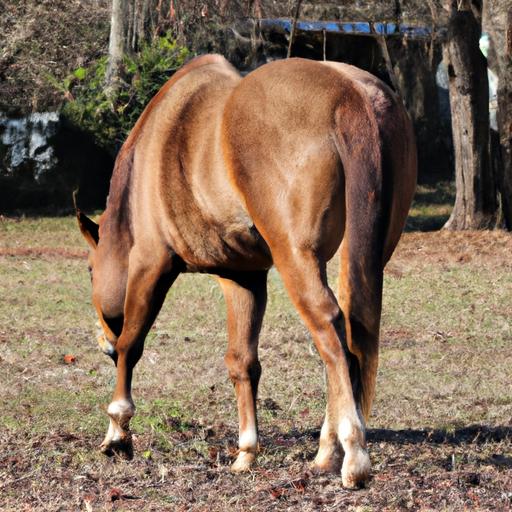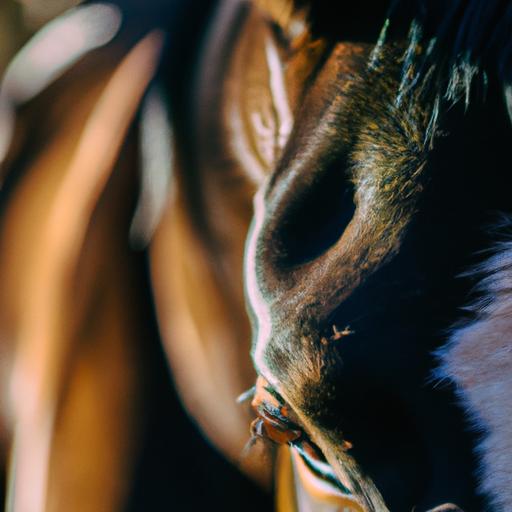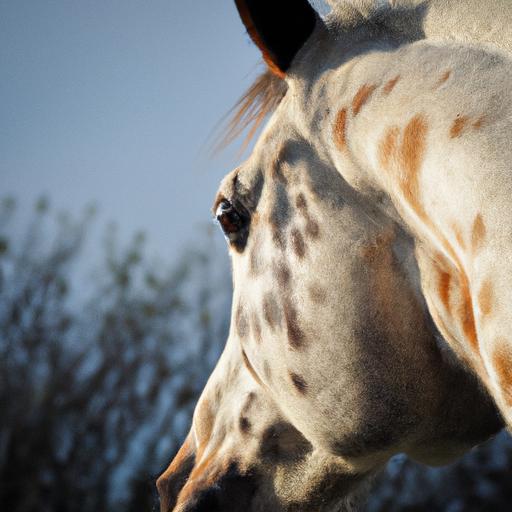are dapples on a horse a sign of good health? Discover the significance of these mesmerizing spots and their link to a horse’s overall well-being.
Introduction

When it comes to assessing the health of a horse, there are numerous factors to consider. One intriguing aspect that often catches the eye of equestrians and enthusiasts is the presence of dapples on a horse’s coat. Dapples, those beautiful light and dark spots that dance across the horse’s body, have long been associated with good health and vitality. But what exactly are dapples, and why are they considered a sign of a healthy horse?
Understanding Dapples on a Horse
Dapples are distinct circular or oval-shaped spots that appear on a horse’s coat. These spots can range in color from lighter shades to deeper hues and create a mesmerizing pattern on the horse’s body. Dapples are particularly prominent on horses with darker coat colors, such as bay or black. While dapples can vary in intensity and size, their presence is often associated with a horse in prime condition.
Significance of Dapples in Assessing Horse Health
Dapples are more than just a visual delight; they can provide valuable insights into a horse’s overall well-being. These spots are often considered a reflection of the horse’s internal health, indicating that the horse is in optimal physical condition. Horse owners and enthusiasts have long regarded dapples as a positive sign, associating them with good nutrition, excellent care, and a fit, active lifestyle.
But what makes dapples such a reliable indicator of good health? Stay tuned as we delve deeper into the link between dapples and a horse’s overall well-being. We’ll explore the factors influencing dapple formation, the implications of dapples on coat and diet, and how dapples can be distinguished from other coat abnormalities. So, let’s unravel the mystery behind these captivating spots and uncover what dapples truly signify when it comes to a horse’s health.
What are Dapples?

Definition and Appearance
Dapples, those mesmerizing spots on a horse’s coat, are a captivating sight for any equestrian enthusiast. These circular or oval-shaped spots create a unique pattern on the horse’s body, adding depth and beauty to their appearance. Dapples can range in color, from lighter shades to deeper hues, and are particularly prominent on horses with darker coat colors, such as bay or black.
The term “dapple” itself refers to the contrast between light and dark areas on the horse’s coat. When dapples are present, they create a stunning visual effect, resembling a play of light and shadow across the horse’s body. These spots are often described as “luminous,” “shimmering,” or “pearlescent,” enhancing the horse’s overall aesthetic appeal.
Factors Influencing Dapple Formation
While dapples are undoubtedly mesmerizing, their formation is influenced by various factors. Understanding these factors can shed light on why dapples are considered a sign of good health in horses. Here are some key factors that contribute to dapple formation:
Genetics and Breed Influence
Genetics play a significant role in determining whether a horse will develop dapples. Certain breeds, such as Friesians and Andalusians, are more prone to dapple formation due to specific genetic characteristics. These breeds often exhibit a higher frequency and intensity of dapples, making them even more prized among enthusiasts.
Nutrition and Balanced Diet
A well-balanced diet is crucial for a horse’s overall health, and it also plays a role in dapple formation. Adequate nutrition, including a balanced mix of essential nutrients, vitamins, and minerals, can promote the development of dapples. Proper nutrition contributes to the horse’s overall condition, which is often reflected in the vibrancy and intensity of their dapples.
By understanding the definition of dapples and the factors that influence their formation, we can begin to appreciate why they are considered a sign of good health in horses. In the next section, we will explore the link between dapples and a horse’s overall well-being, delving deeper into the implications of dapples on coat and diet. So, let’s continue our journey of understanding the significance of dapples in assessing horse health.
The Link Between Dapples and Good Health

Dapples as an Indicator of Overall Condition
Have you ever wondered why dapples are often associated with a horse’s good health? The presence of dapples on a horse’s coat is believed to be a visual representation of the horse’s overall condition. When a horse is in optimal health, with a balanced diet and proper care, it can manifest in the form of vibrant and well-defined dapples.
Dapples are thought to be a reflection of a horse’s internal well-being. They indicate that the horse is receiving adequate nutrition, including essential vitamins, minerals, and fatty acids. Furthermore, dapples are frequently seen on horses that are physically fit and have good muscle tone. So, if you spot strong and prominent dapples on your horse’s coat, it is likely a testament to their excellent overall condition.
Implications of Dapples on Coat and Diet
The presence or absence of dapples can also offer insights into a horse’s diet and coat quality. Dapples are often more pronounced on horses with a shiny, glossy coat. This indicates that the horse’s skin and coat are in optimum condition, likely due to a well-balanced diet and appropriate grooming practices. A diet rich in essential nutrients, such as omega-3 fatty acids and antioxidants, can contribute to the development of dapples and a lustrous coat.
On the other hand, the absence of dapples or a dull, lackluster coat may indicate potential nutritional deficiencies or health issues. In such cases, it is crucial to assess the horse’s diet and consult with a veterinarian to ensure they receive the necessary nutrients for optimal health.
In conclusion, dapples serve as a valuable visual indicator of a horse’s overall condition and well-being. Their presence suggests that the horse is receiving proper nutrition, sufficient exercise, and excellent care. However, it is important to remember that dapples should not be the sole factor in assessing a horse’s health. Regular veterinary check-ups and a holistic approach to horse care are essential to ensure the well-being of your equine companion.
Factors Affecting Dapple Formation
Dapples on a horse’s coat are not solely a result of good health; several factors come into play when it comes to their formation. Understanding these factors can help horse owners and enthusiasts better comprehend the significance of dapples and how to promote their development.
A. Genetics and Breed Influence
Genetics play a crucial role in determining whether a horse will develop dapples or not. Certain horse breeds are more prone to dapple formation, while others may rarely exhibit them. For instance, some breeds known for their dappled coats include the Friesian, Andalusian, and Appaloosa. These breeds possess specific genetic traits that contribute to the development of dapples. It’s important to note that not all horses within these breeds will necessarily have dapples, as individual genetic variations can still come into play.
B. Nutrition and Balanced Diet
A well-balanced diet plays a significant role in the formation of dapples. Horses that receive proper nutrition are more likely to exhibit vibrant and pronounced dapples. Essential nutrients, such as proteins, vitamins, and minerals, are crucial for maintaining healthy skin and coat. A diet lacking in these nutrients may result in dull or faded dapples. To promote dapple formation, ensure your horse’s diet includes high-quality forage, grains, and supplements tailored to meet their specific nutritional needs.
C. Exercise and Fitness
Regular exercise and fitness also contribute to the development of dapples. Horses that engage in regular physical activity tend to have better blood circulation, which can enhance the appearance of their coat and dapples. Exercise helps maintain a healthy weight, muscle tone, and overall well-being, all of which can positively impact dapple formation. Providing your horse with ample opportunities for turnout, exercise, and mental stimulation can contribute to the development of robust and vibrant dapples.
By understanding these factors, you can actively promote the formation of dapples and support your horse’s overall health and well-being. Genetics, nutrition, and exercise all play a vital role in the development of these captivating spots. So, make sure to provide your horse with the right genetics, a balanced diet, and regular exercise to enhance the beauty and health of their coat.
Dapples vs. Other Coat Abnormalities
A. Distinguishing Dapples from Other Spots
When examining a horse’s coat, it is essential to differentiate dapples from other spots or markings that may appear similar at first glance. Dapples have a distinct appearance that sets them apart from other coat abnormalities. Here’s how you can identify dapples:
-
Circular or Oval Shape: Dapples are typically round or oval-shaped, forming well-defined spots on the horse’s coat. Other spots, such as flecks or irregular markings, may lack the characteristic shape of dapples.
-
Variation in Color: Dapples exhibit a unique play of light and dark shades, creating a multi-dimensional effect on the horse’s coat. These spots may have a darker center with a lighter outer ring or vice versa. In contrast, other spots may lack this variation in color intensity.
-
Consistency Across the Body: Dapples tend to appear consistently across the horse’s body, rather than being isolated to specific areas. They often cover the entire body or are distributed evenly, giving the horse a stunning overall appearance.
B. Identifying Potential Health Issues from Coat Irregularities
While dapples are generally associated with good health, it is important to be aware of other coat irregularities that may indicate underlying health issues in horses. Here are some common abnormalities to watch out for:
-
Patchy Coat: A patchy or uneven coat, with areas of hair loss or thinning, can be a sign of various conditions, including nutritional deficiencies, skin infections, or hormonal imbalances.
-
Dull or Faded Coat: A lackluster or faded coat may indicate poor nutrition, inadequate grooming, or underlying health problems such as parasites or diseases.
-
Excessive Shedding: Excessive shedding beyond the normal seasonal shedding can signal health issues like hormonal imbalances or underlying systemic conditions.
If you notice any of these coat irregularities, it is crucial to consult with a veterinarian. They can help determine the underlying cause and provide appropriate treatment to restore your horse’s coat to its optimal condition. Remember, maintaining a healthy coat is not only aesthetically pleasing but also an essential aspect of your horse’s overall well-being.


